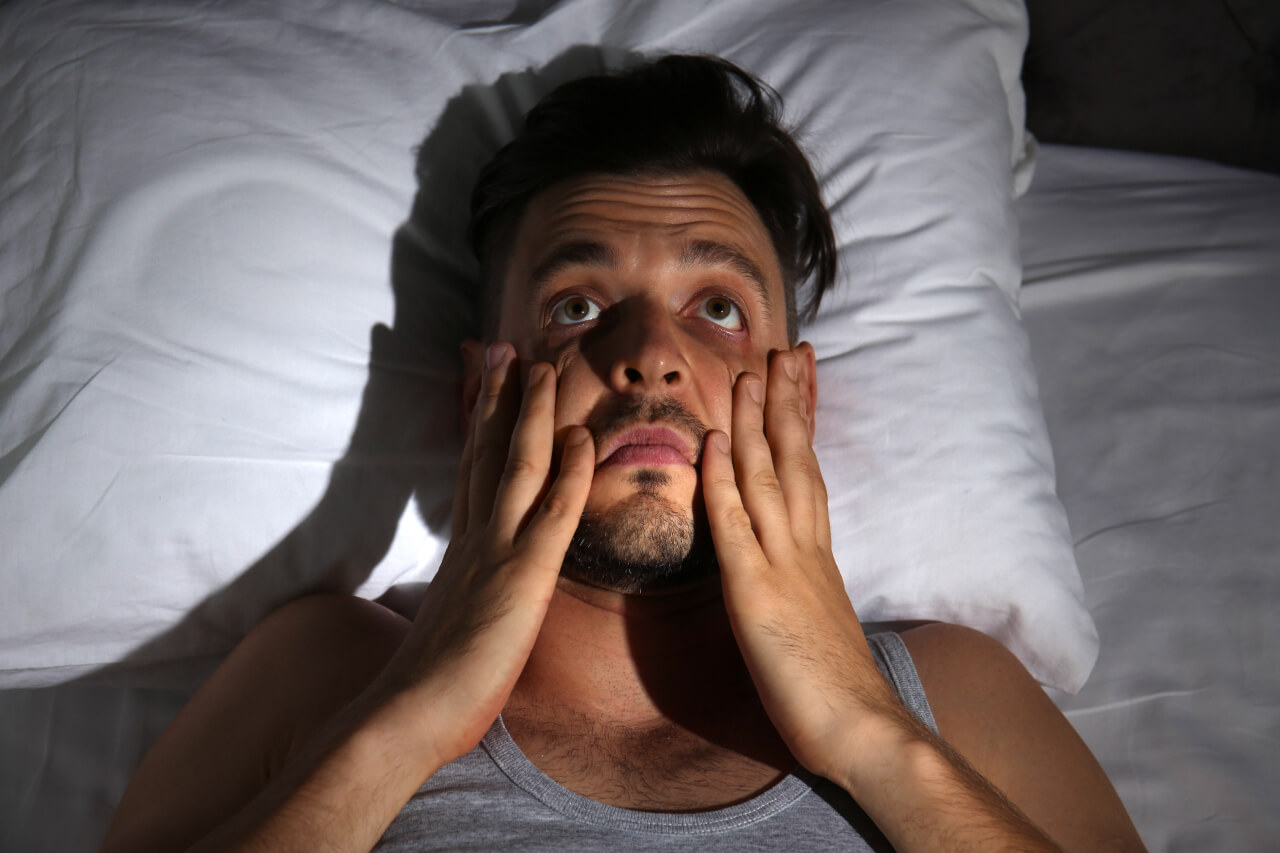Insomnia is the sleep disorder characterized by difficulty falling asleep, staying asleep, or experiencing non-restorative sleep.
It can lead to various daytime impairments, including fatigue, mood disturbances, and difficulties in concentration.
Insomnia can be acute, lasting for a short period, or chronic, persisting for months or even years.
While many are familiar with the challenges of falling and staying asleep, there exists a subset of insomnia types that often fly under the radar—three lesser-known manifestations that add complexity to the intricate world of sleep disorders.
Join us as we unravel the threads of these lesser-known insomnia types, shedding light on the complexities that shape our understanding of sleep and its elusive nature.
Psychophysiological Insomnia
Psychophysiological insomnia is a type of sleep disorder characterized by difficulty falling asleep or staying asleep, often driven by psychological factors.
Unlike some other forms of insomnia that may have clear external triggers, psychophysiological insomnia is closely linked to learned behaviors and heightened arousal related to the sleep.
Causes
Psychophysiological insomnia is primarily driven by psychological and learned behavioral factors.
Several key causes contribute to the development and perpetuation of this type of insomnia:
- Excessive Worry and Anxiety:
Persistent and excessive worry about the ability to fall asleep or the consequences of not getting enough sleep can create a cycle of heightened arousal.
This anxiety becomes a central factor in the development of psychophysiological insomnia. - Conditioned Responses:
Over time, the association between the sleep environment (bed, bedroom, etc.) and the anxiety about sleep can lead to conditioned responses.
The bed, which should be a place of relaxation, becomes associated with stress and alertness, making it challenging to initiate sleep. - Poor Sleep Habits:
Irregular sleep schedules, inconsistent bedtime routines, and other poor sleep habits can contribute to the development of psychophysiological insomnia.
These habits can disrupt the body’s natural sleep-wake cycle and contribute to difficulties falling asleep. - Hyperarousal:
Individuals with psychophysiological insomnia often experience a state of hyperarousal, where the mind and body remain in a heightened state of alertness.
This physiological arousal makes it difficult for the individual to relax and transition into a restful sleep state. - Previous Sleep Difficulties:
Past experiences of difficulty sleeping, whether due to temporary stressors or other factors, can contribute to the development of psychophysiological insomnia.
The fear of a repeat episode can perpetuate the cycle of anxiety and sleep disturbance. - Negative Sleep Associations:
Negative experiences associated with sleep, such as a history of insomnia or nightmares, can create negative associations with bedtime and sleep, further complicating the ability to relax and fall asleep.
Treatment
The treatment for psychophysiological insomnia typically involves a combination of behavioral interventions, lifestyle changes, and, in some cases, pharmacological approaches.
Here are common treatment strategies:
- Cognitive-Behavioral Therapy for Insomnia (CBT-I):
CBT-I is considered the gold standard for treating psychophysiological insomnia.
This therapeutic approach addresses maladaptive thoughts and behaviors related to the sleep.
It may include components such as cognitive restructuring, stimulus control, sleep restriction, and relaxation techniques. - Sleep Hygiene Education:
Educating individuals about the sleep practices is an essential component of treatment.
This may involve recommendations for maintaining a consistent sleep schedule, creating a comfortable sleep environment, and adopting relaxation rituals before bedtime. - Stimulus Control Therapy:
This technique aims to break the association between the bed and anxiety or arousal.
It involves specific guidelines, such as using the bed only for sleep and intimacy, getting out of bed if unable to sleep, and returning to bed only when sleepy. - Sleep Restriction:
Sleep restriction involves limiting the time spent in bed to the actual amount of time spent asleep.
This helps consolidate sleep and reduce time spent awake in bed, gradually improving sleep efficiency. - Relaxation Techniques:
Techniques such as progressive muscle relaxation, deep breathing exercises, or guided imagery can help individuals with psychophysiological insomnia relax and reduce anxiety before bedtime. - Biofeedback:
Biofeedback involves using electronic monitoring to provide individuals with information about physiological processes such as muscle tension.
Through this feedback, individuals can learn to control and reduce tension, promoting relaxation. - Medication:
In some cases, short-term use of medication may be considered to help regulate sleep patterns.
However, medications are typically not the first line of treatment and are often used in conjunction with behavioral therapies. - Lifestyle Changes:
Encouraging overall healthy lifestyle habits, including regular physical activity, a balanced diet, and stress management, can contribute to improved sleep.
The specific treatment plan will vary based on individual needs and the severity of the insomnia.
It’s crucial for individuals with psychophysiological insomnia to work closely with healthcare professionals, such as sleep specialists or psychologists, to develop a personalized and effective treatment approach.
Paradoxical Insomnia (The Sleep State Misperception)
Paradoxical Insomnia, also known as The Sleep State Misperception or subjective insomnia, is a type of sleep disorder where individuals consistently underestimate the amount of sleep they are getting.
Despite objective evidence indicating normal sleep duration and quality, individuals with paradoxical insomnia believe that they are sleeping very little or not at all.
Paradoxical Insomnia is considered relatively uncommon compared to other types of the sleep disorders.
While paradoxical insomnia, also known as The Sleep State Misperception or subjective insomnia, may be less common, its impact on the individual’s well-being can be significant.
Recognition and understanding of the sleep disorder are crucial for accurate diagnosis and appropriate management, often involving a multidimensional approach that addresses both the subjective perception of sleep and any underlying psychological factors.
Causes
The exact causes of Paradoxical Insomnia, also known as The Sleep State Misperception or subjective insomnia, are not fully understood.
Several factors may contribute to its development:
- Heightened Sleep Awareness:
Individuals with paradoxical insomnia often exhibit an increased awareness of their sleep and a hyperfocus on the quality and quantity of sleep they perceive.
This heightened attention to sleep may lead to an overestimation of sleep difficulties. - Cognitive Factors:
Maladaptive thought patterns, including negative beliefs about sleep and persistent worry about not getting enough sleep, can contribute to the development and maintenance of paradoxical insomnia.
Cognitive factors may play a role in shaping the individual’s perception of their sleep. - Anxiety and Stress:
Elevated levels of anxiety and stress are commonly associated with paradoxical insomnia.
These psychological factors can create a state of hyperarousal, making it challenging for individuals to relax and perceive their sleep accurately. - Sleep-related Conditioning:
Negative experiences related to sleep, such as past episodes of insomnia or disruptive sleep events, may contribute to the development of paradoxical insomnia.
These negative associations can influence an individual’s beliefs and expectations about sleep. - Circadian Rhythm Disruptions:
Irregularities in the natural circadian rhythm or disruptions in the sleep-wake cycle can impact sleep perception.
Shift work, irregular sleep schedules, or exposure to artificial light during the night may play a role in paradoxical insomnia. - Other Sleep Disorders:
Coexisting sleep disorders, such as sleep apnea or insomnia with objective sleep disturbances, can complicate sleep perception.
Individuals may focus on specific aspects of their sleep difficulties while overlooking the presence of other sleep disorders. - Neurobiological Factors:
There may be underlying neurobiological factors that influence the processing of sleep-related information in the brain, contributing to the misperception of sleep-in individuals with paradoxical insomnia.
Treatment
The treatment for Paradoxical Insomnia, also known as The Sleep State Misperception or subjective insomnia, often involves addressing both the subjective perception of sleep and any underlying psychological factors.
Here are common treatment strategies:
- Cognitive-Behavioral Therapy for Insomnia (CBT-I):
CBT-I is a highly effective and evidence-based approach for treating paradoxical insomnia.
This therapeutic intervention aims to modify maladaptive thought patterns and behaviors related to sleep.
Techniques may include cognitive restructuring to challenge negative beliefs about sleep, stimulus control to establish a positive association with the bed, and sleep restriction to improve sleep efficiency. - Sleep Hygiene Education:
Educating individuals about healthy sleep practices is an important component of treatment. This may involve recommendations for maintaining a consistent sleep schedule, creating a comfortable sleep environment, and adopting relaxation rituals before bedtime. - Objective Sleep Measures:
While subjective reports are significant, objective sleep measures such as polysomnography or actigraphy can provide concrete evidence of sleep patterns.
Sharing the objective data with the individual can help them understand the disparity between their perception and reality. - Addressing Psychological Factors:
Since paradoxical insomnia is often associated with heightened levels of anxiety and stress, addressing these psychological factors is crucial.
Stress management techniques, relaxation exercises, and, if necessary, psychotherapy can help individuals manage anxiety and improve their overall mental well-being. - Sleep Restriction:
In some cases, sleep restriction techniques may be employed to consolidate sleep and improve sleep efficiency.
This involves limiting the time spent in bed to the actual amount of time spent asleep. - Biofeedback:
Biofeedback techniques can be used to provide individuals with information about physiological processes, such as muscle tension, and help them learn to control and reduce tension, promoting relaxation. - Patient Education:
Providing individuals with information about the nature of paradoxical insomnia, the common misperceptions about sleep, and the potential effectiveness of treatment can be empowering. This education can help individuals develop a more accurate understanding of their sleep patterns.
Idiopathic Insomnia
Idiopathic Insomnia is a rare and chronic sleep disorder characterized by persistent difficulties falling asleep or maintaining adequate sleep, with no discernible underlying cause.
The term “idiopathic” indicates that the condition arises spontaneously or from an unknown origin.
Unlike other types of insomnia that may be linked to specific triggers or underlying health issues, idiopathic insomnia tends to persist throughout an individual’s life without a clear explanation.
The condition is typically present from an early age, distinguishing it from other forms of insomnia that may develop later in life.
Idiopathic insomnia is a chronic condition, lasting for months, years, or even a lifetime.
Despite efforts to improve sleep hygiene or implement behavioral changes, individuals with idiopathic insomnia continue to face persistent difficulties with sleep.
Causes
The exact cause of Idiopathic Insomnia is not well understood, and it is considered a rare and mysterious sleep disorder.
Several factors may contribute to the development of idiopathic insomnia, but none have been definitively identified.
Here are some potential factors that researchers and healthcare professionals have considered:
- Neurobiological Factors:
There may be subtle abnormalities or differences in the neurobiological mechanisms that regulate sleep in individuals with idiopathic insomnia.
However, these specific factors remain largely unknown. - Genetic Predisposition:
Some studies suggest a genetic component to idiopathic insomnia, with a potential familial link.
However, the specific genetic factors contributing to the disorder have not been identified. - Altered Sleep Homeostasis:
The body’s natural sleep-wake homeostasis, which regulates the balance between sleep and wakefulness, may be disrupted in individuals with idiopathic insomnia.
This disruption could contribute to the persistent difficulties in initiating or maintaining sleep. - Hypersensitivity to Sleep Environment:
Individuals with idiopathic insomnia may be hypersensitive to stimuli in their sleep environment, making it challenging for them to relax and fall asleep.
This heightened sensitivity may contribute to the chronic nature of the disorder. - Abnormalities in Sleep Architecture:
While polysomnography often reveals normal sleep architecture in individuals with idiopathic insomnia, there may be subtle, undetected abnormalities in the way sleep stages are regulated or transitioned. - Early Onset and Lifelong Nature:
The fact that idiopathic insomnia often manifests in childhood and persists throughout a person’s life suggests that there may be developmental factors at play.
It could be related to the maturation of the sleep-wake regulatory system.
It’s important to note that these proposed factors are speculative, and research on idiopathic insomnia is ongoing.
Since idiopathic insomnia is a diagnosis of exclusion, healthcare professionals first rule out other potential causes of insomnia before considering it as the primary diagnosis.
The diagnosis of idiopathic insomnia is often challenging, and the healthcare provider will use a combination of subjective reports, objective measures, and clinical judgment.
It requires careful consideration of the chronic and lifelong nature of the sleep difficulties and the absence of an identifiable cause.
Treatment
The treatment for Idiopathic Insomnia focuses on managing symptoms, improving sleep quality, and enhancing overall well-being.
While there is no specific cure for idiopathic insomnia due to its chronic and lifelong nature, various therapeutic approaches can help individuals cope with sleep difficulties.
Here are common treatment strategies:
- Cognitive-Behavioral Therapy for Insomnia (CBT-I):
CBT-I is a structured and evidence-based approach that addresses maladaptive thought patterns and behaviors related to sleep.
It includes components such as cognitive restructuring, stimulus control, sleep restriction, and relaxation techniques. - Sleep Hygiene Education:
Educating individuals about healthy sleep practices and lifestyle habits is crucial.
This may involve recommendations for maintaining a consistent sleep schedule, creating a comfortable sleep environment, and adopting relaxation rituals before bedtime. - Biofeedback:
Biofeedback techniques can be employed to provide individuals with information about physiological processes (e.g., muscle tension) and help them learn to control and reduce tension, promoting relaxation. - Pharmacological Interventions:
Medications are not typically the first-line treatment for idiopathic insomnia.
However, in some cases, healthcare providers may consider short-term use of sleep medications to improve sleep quality.
This approach is generally used cautiously, given the potential risks of dependence and tolerance associated with certain medications. - Lifestyle Modifications:
Encouraging overall healthy lifestyle habits, including regular physical activity, a balanced diet, and stress management, can contribute to improved sleep quality and overall well-being. - Psychological Support:
Given the chronic nature of idiopathic insomnia, psychological support may be beneficial. Psychotherapy or counseling can help individuals explore and address any psychological factors, stressors, or emotional challenges that may contribute to sleep difficulties. - Support Groups:
Participating in support groups or connecting with others who experience similar sleep challenges can provide a sense of understanding and shared coping strategies. - Regular Follow-Up:
Ongoing follow-up with healthcare professionals is crucial to monitor progress, assess the effectiveness of interventions, and make adjustments to the treatment plan as needed.
It’s important to note that treatment approaches may vary based on individual needs and preferences.
Developing a tailored and holistic treatment plan, often through collaboration between the individual and healthcare providers, is essential.
The goal is to improve the individual’s ability to cope with the sleep difficulties, enhance overall well-being, and optimize their quality of life despite the chronic nature of idiopathic insomnia.
Conclusion
In the realm of the sleep disorders, where the nuances of rest and wakefulness intertwine, three lesser-known insomnia types—Psychophysiological Insomnia, Paradoxical Insomnia, and Idiopathic Insomnia—unfold as enigmatic phenomena, challenging our understanding of sleep.
Psychophysiological Insomnia unveils the intricate dance between learned behaviors, heightened arousal, and the elusive pursuit of rest.
It is a manifestation where the mind, burdened by excessive worry, weaves a tapestry of conditioned responses, complicating the journey into slumber.
Paradoxical Insomnia, or The Sleep State Misperception, takes us into the paradoxical realm where perception and reality diverge.
Despite objective evidence of sufficient sleep, individuals grapple with a persistent belief in sleep inadequacy, unveiling the intricate interplay between subjectivity and objectivity in the realm of sleep. Finally, Idiopathic Insomnia, a rare and lifelong companion, emerges as a chronic mystery, shrouded in the absence of an identifiable cause.
Beginning in childhood, its enigmatic nature persists, challenging both those who experience it and those who seek to unravel its origins.
Diagnosing these lesser-known insomnia types demands a delicate dance between subjective narratives and objective measures.
Clinical interviews, sleep diaries, and objective assessments such as polysomnography provide glimpses into the intricate landscapes of sleep perception.
The journey of diagnosis often involves exclusion, ruling out other potential causes while navigating the subjective intricacies that define each insomnia type.
Each diagnosis is a puzzle, a synthesis of experiences and objective data that guides the path toward understanding and management.
Treatment for these lesser-known insomnia types is as nuanced as the conditions themselves.
Cognitive-behavioral therapies, sleep hygiene education, and behavioral interventions form the cornerstone of addressing the psychological and behavioral intricacies woven into the fabric of these sleep disorders.
Yet, as we explore the therapeutic landscape, we encounter the uniqueness of each individual’s experience, requiring a tailored approach that respects the complexity of their sleep journey.
In the face of chronic challenges, the pursuit of effective treatment becomes a collaborative dance, with healthcare providers and individuals moving together to alleviate the burdens of sleep disturbances.
In conclusion, the exploration of Psychophysiological Insomnia, Paradoxical Insomnia, and Idiopathic Insomnia reveals the multifaceted nature of sleep disorders.
These lesser-known insomnia types not only deepen our appreciation for the complexities of sleep but also underscore the importance of a personalized and holistic approach to diagnosis and treatment.
FAQs
What is Psychophysiological Insomnia?
Psychophysiological Insomnia is a type of the sleep disorder characterized by difficulty falling or staying asleep, driven by excessive worry about sleep and the development of conditioned responses.
How is Psychophysiological Insomnia diagnosed?
Diagnosis involves a clinical evaluation, sleep diary, and, if necessary, objective measures like polysomnography. Identification of learned behaviors and heightened arousal is crucial.
What causes Psychophysiological Insomnia?
Psychological factors, including excessive worry and conditioned responses, contribute to the development of Psychophysiological Insomnia.
What is Paradoxical Insomnia (Sleep State Misperception)?
Paradoxical Insomnia is characterized by individuals perceiving significant sleep deprivation despite objective evidence suggesting the sleep patterns.
How is Paradoxical Insomnia diagnosed?
Diagnosis involves a combination of clinical interviews, sleep diaries, and, when necessary, objective sleep measures like polysomnography.
Why is Paradoxical Insomnia not common?
Paradoxical Insomnia is considered uncommon due to the subjective nature of perception and potential overlap with other insomnia types.
What causes Paradoxical Insomnia?
Factors may include heightened sleep awareness, cognitive influences, anxiety, and an inherent subjective misperception of sleep.
What is Idiopathic Insomnia?
Idiopathic Insomnia is a rare and chronic sleep disorder characterized by persistent difficulties falling or staying asleep, with no discernible underlying cause.
How is Idiopathic Insomnia diagnosed?
Diagnosis involves a thorough clinical evaluation, sleep history, objective measures, and the exclusion of other potential causes of insomnia.
What causes Idiopathic Insomnia?
The exact cause is unknown, but potential factors include neurobiological differences, genetic predisposition, and disruptions in sleep homeostasis.
What is the treatment for Idiopathic Insomnia?
Treatment focuses on managing symptoms and improving the sleep quality. Behavioral interventions, sleep hygiene education, and, in some cases, medication may be recommended.





